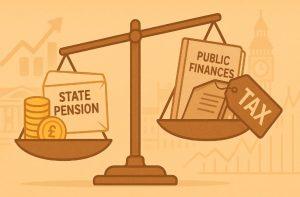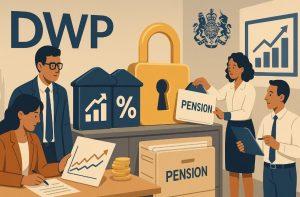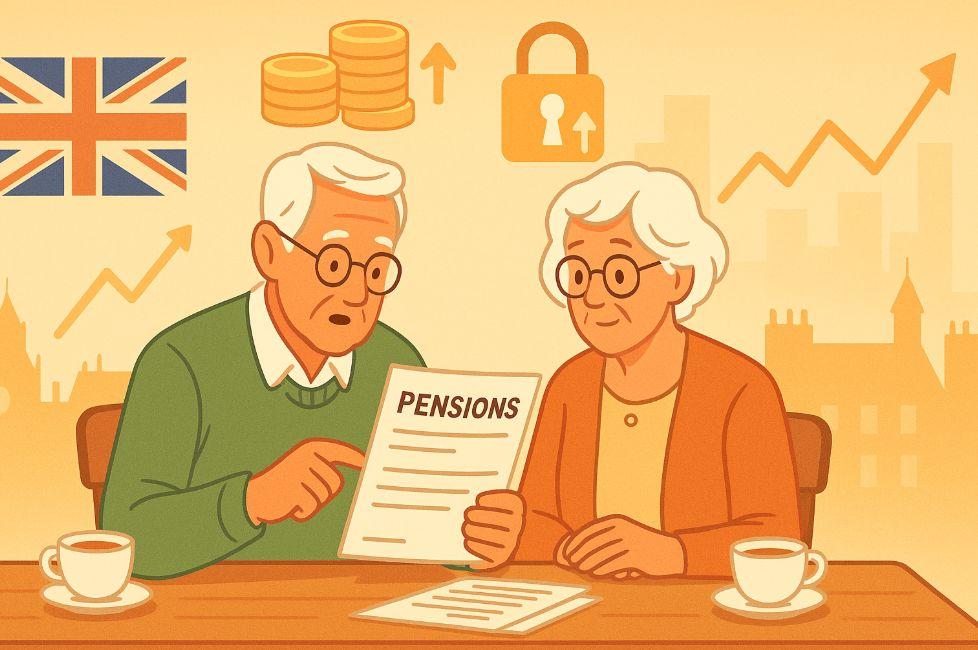The triple lock on pensions has long been a cornerstone of the UK’s retirement income system, promising guaranteed annual increases to the state pension. While it may sound like a simple safeguard, its real-world implications are far more complex. Behind every pension rise lies a delicate balance between economic sustainability, political decisions, and generational equity.
This blog explores the mechanics of the triple lock, its benefits, its long-term costs, and what it could mean for the future of retirement in Britain.
What Does the Triple Lock on Pension Actually Mean?

Definition of the Triple Lock
The triple lock is a policy mechanism used by the UK government to ensure that the state pension increases each year by the highest of three measures:
- Inflation as measured by the Consumer Price Index (CPI)
- Average earnings growth
- A fixed minimum of 2.5%
This policy was introduced to maintain the purchasing power of pensioners, ensuring that their income rises in line with economic growth or cost of living.
Purpose of the Triple Lock
The triple lock aims to prevent pensioners from falling into poverty, particularly during times of economic volatility. By anchoring pension increases to inflation or earnings, or ensuring a minimum rise, the system provides a level of income stability that many retirees rely on.
Why Was the Triple Lock Introduced in the UK?
Historical Background
The UK’s triple lock system was implemented in 2010 during the coalition administration formed between the Conservatives and the Liberal Democrats, aiming to safeguard pensioner incomes. Before this, pensions were largely linked to inflation, which often meant that increases were modest, and pensioners’ income lagged behind average earnings.
Political Drivers
The introduction of the triple lock was partly driven by growing concerns about pensioner poverty and declining trust in public retirement provision. With the UK having one of the lowest state pensions relative to average earnings among developed countries, the triple lock was seen as a politically palatable solution to reverse declining pension values.
How Does the Triple Lock Affect State Pension Increases?
Annual Increases Explained
Each year, the government assesses which of the three metrics CPI, average earnings, or 2.5% is highest, and then increases the state pension accordingly. For example, if average earnings increase by 6.7%, but CPI inflation is 4.2%, pensioners receive a 6.7% increase.
Impact Over Time
The cumulative effect of the triple lock can be significant. Pensioners have seen above-inflation increases during periods of strong wage growth or inflation spikes.
Real-Life Example
In April 2024, the full new state pension rose by 8.5% due to strong wage growth well above the rate of inflation, which was 6.7%.
What Are the Financial Implications of the Triple Lock?

Cost to the Treasury
The triple lock is expensive. According to the Office for Budget Responsibility (OBR), the policy will cost the government an additional £10 billion annually by the end of the decade if maintained. This growing burden raises questions about the sustainability of pension funding.
Fiscal Trade-Offs
The rising cost means cuts may be needed elsewhere such as in public services or infrastructure or higher taxes might be imposed on the working-age population. This creates tension between generations, fuelling political and social debates.
Is the Triple Lock Policy Fair Across Generations?
Intergenerational Fairness Debate
Critics argue that the triple lock disproportionately benefits older generations at the expense of younger taxpayers. As pensioners receive protected income increases, working individuals face stagnating wages and rising living costs without similar protections.
Impact on Younger Generations
With fewer young people owning homes or building adequate pension pots, there’s growing concern that the system is skewed towards current retirees, rather than creating a balanced retirement model for future generations.
Could the Triple Lock Be Suspended or Reformed?
Historical Precedent for Suspension
In 2021, the triple lock was temporarily suspended due to anomalous wage growth caused by COVID-19 furlough distortions. Instead, pensions increased by inflation alone a move that saved the government billions.
Ongoing Political Debates
There is regular discussion among policymakers about replacing the triple lock with a “double lock” (removing the 2.5% guarantee) or linking it solely to inflation or earnings. However, such moves are politically risky, especially with the pensioner population being a key voting demographic.
How Does the UK Compare to Other Countries in Pension Protection?

International Context
Many developed countries use different systems to index pensions:
- USA: Tied to inflation via CPI-W
- Germany: Uses wage indexation
- Australia: Mixes inflation and average weekly earnings
The UK’s triple lock is relatively generous, particularly during economic fluctuations.
UK’s Position Globally
While generous, the UK still ranks lower in terms of state pension as a percentage of average income. Despite generous yearly rises under the triple lock, the UK’s state pension still begins at a level significantly lower than many other developed nations, highlighting a critical imbalance.
What Can Pensioners Expect in the Future with the Triple Lock?
Forecast for Coming Years
Projections suggest that pensions could rise by another 6-7% in April 2025 due to current inflation and earnings trends. However, this assumes the triple lock remains intact through upcoming general elections.
Party Manifestos and Commitments
As of 2025, major UK parties remain non-committal. While the Conservative Party pledges to maintain the triple lock, others propose reforms to balance costs and fairness.
What Are the Alternatives to the Triple Lock Mechanism?
Potential Models
Several alternative indexing systems are under consideration:
- Double Lock: Removing the 2.5% floor
- Earnings-Only: Linking solely to wage growth
- Inflation-Only: Using CPI or RPI exclusively
These models offer cost savings but reduce pensioner income growth during low economic growth periods.
Long-Term Planning
Some think tanks recommend a mixed or dynamic approach adjusting the formula based on fiscal performance or inflation thresholds to create a more flexible but still protective model.
What Role Does the Department for Work and Pensions (DWP) Play in the Triple Lock?

Overview of DWP’s Authority
In the UK, the Department for Work and Pensions (DWP) oversees public welfare systems, including pensions. It administers the state pension and implements yearly increases by applying the triple lock criteria.
Process of Setting Pension Rates
Each year, the DWP gathers inflation data from the Office for National Statistics (ONS) and reviews average earnings figures from national payrolls. These are then assessed against the 2.5% floor. The highest value becomes the percentage by which the state pension is increased, effective every April.
Once decided, this figure is announced in the Chancellor’s Autumn Budget or Spending Review and then passed through legislative approval before being applied. This process guarantees transparency and allows Parliament to maintain control over how pension adjustments are carried out.
Interaction with Other Government Agencies
The DWP works in tandem with HM Treasury and the OBR to assess the affordability and economic impact of the triple lock. These forecasts influence future policy decisions and budget allocations, especially during economic downturns or political change.
How Is the Triple Lock Impacting the UK’s Long-Term Pension Strategy?
Sustainability Challenges
The long-term implications of maintaining the triple lock are being carefully scrutinised. With an ageing population and increasing life expectancy, the UK government faces mounting pressure to find a balance between providing adequate pension income and managing public expenditure.
Experts suggest that, unless reformed, the triple lock could become unsustainable by the early 2030s. Forecasts from the OBR estimate that pension-related spending could reach over £150 billion annually if current trends continue.
Influence on Retirement Planning
The triple lock’s existence creates uncertainty in long-term retirement planning. While it currently benefits pensioners, younger generations are left wondering whether the same system will exist by the time they retire. This uncertainty can undermine confidence in state pension provision and increase reliance on private pension schemes.
Calls for Reform
Policy institutes like the Institute for Fiscal Studies (IFS) and the Resolution Foundation have recommended reforms such as:
- Capping annual increases during economic surges
- Shifting to a “smoothed” earnings and inflation average
- Introducing means-tested boosts for the most vulnerable pensioners
These proposals aim to retain pensioner protections while keeping the system financially viable for future generations.
Annual State Pension Increases Under Triple Lock (2013–2024)
| Year | CPI Inflation (%) | Average Earnings Growth (%) | 2.5% Minimum | Applied Increase (%) | Reason |
| 2013 | 2.2 | 1.6 | 2.5 | 2.5 | Minimum Guarantee |
| 2014 | 2.7 | 1.2 | 2.5 | 2.7 | CPI |
| 2015 | 1.2 | 0.6 | 2.5 | 2.5 | Minimum Guarantee |
| 2016 | -0.1 | 2.9 | 2.5 | 2.9 | Earnings |
| 2017 | 1.0 | 2.4 | 2.5 | 2.5 | Minimum Guarantee |
| 2018 | 3.0 | 2.8 | 2.5 | 3.0 | CPI |
| 2019 | 2.4 | 2.6 | 2.5 | 2.6 | Earnings |
| 2020 | 1.7 | 3.9 | 2.5 | 3.9 | Earnings |
| 2021 | 0.5 | Suspended | 2.5 | 2.5 | Temporary Double Lock |
| 2022 | 3.1 | 8.3 (suspended) | 2.5 | 3.1 | CPI |
| 2023 | 10.1 | 6.2 | 2.5 | 10.1 | CPI |
| 2024 | 6.7 | 8.5 | 2.5 | 8.5 | Earnings |
Conclusion
The triple lock has transformed how UK pensioners experience retirement income growth. While it offers protection against inflation and economic hardship, its long-term affordability and fairness are under scrutiny. Any future decisions will need to carefully weigh the economic realities against the moral and social contract owed to older generations.
FAQ About Triple Lock on Pension
What are the three components of the triple lock?
The triple lock ensures pension increases based on the highest of inflation (CPI), average earnings growth, or a guaranteed minimum of 2.5%.
Why was the triple lock suspended in 2021?
It was temporarily suspended due to distorted wage growth during the COVID-19 pandemic to prevent an unaffordable pension increase.
How much is the full UK state pension in 2024?
As of April 2024, the full new state pension is £221.20 per week, totalling over £11,500 annually.
Will the triple lock be scrapped in the future?
While no official plans exist to scrap it, political debate continues due to its financial burden and generational impact.
How is the pension increase calculated each year?
Each autumn, the government assesses CPI inflation (September), average earnings growth (July), and applies the highest by April.
Does the triple lock apply to private pensions?
No. The triple lock only applies to the UK’s state pension. Private pensions follow market performance or fixed annual increments.
How does the triple lock affect public finances?
Maintaining the triple lock increases state expenditure by billions annually, raising concerns about its long-term affordability.









Leave feedback about this